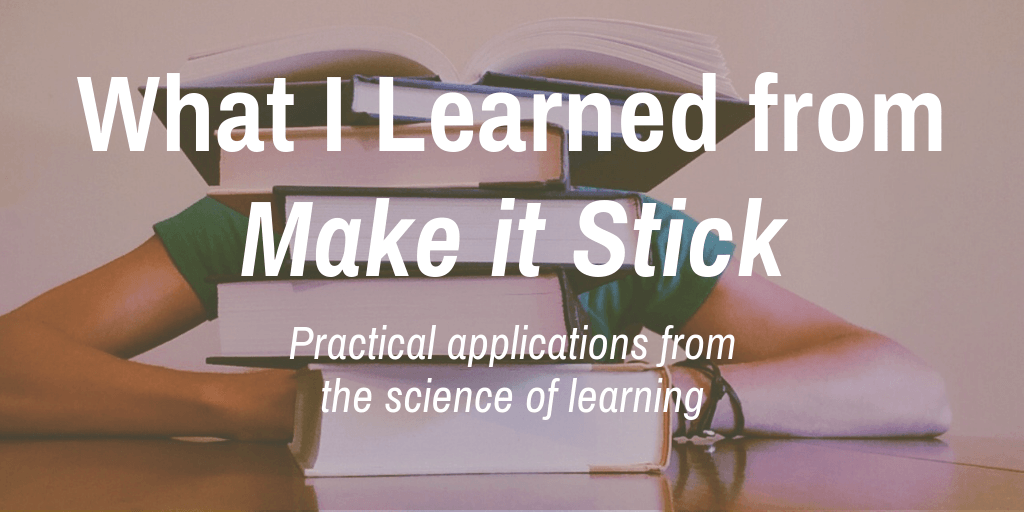Much of our understanding about how we learn is flawed. The typical advice given to students is single-minded, focused repetition, reflecting the belief that if we expose ourselves to something enough, we can burn it into memory. This is called “massed practice” by cognitive scientists and “cramming” by students. Given this advice, it should come as no surprise that one of college students’ most commonly reported study habits is to re-read their textbook or their notes. Unfortunately, this and other forms of massed practice are some of the least-effective methods of learning! As Brown, Roediger, and McDaniel write in their book Make it Stick: The Science of Successful Learning:
“The fact that you can repeat the phrases in a text or your lecture notes is no indication that you understand the significance of the precepts they describe, their application, or how they relate to what you already know about the subject” (p. 16).
However, despite the research demonstrating that simple repetition does not lead to long-term retention, we rely on massed practice because it can produce quick results. But it’s an illusion of mastery — the retention of information is short-lived and does not encourage the application of knowledge to novel situations. Most students don’t know this, and many aren’t bothered by it as long as they can pass the exam. So it’s our responsibility to help students see the benefits of using the following research-supported techniques to improve their learning.
Spaced Practice
When faced with an exam, many students engage in cramming or pull “all-nighters.” While this practice may help some students pass, the information is quickly forgotten. In contrast, spaced practice divides studying into installments, allowing time to elapse in between. One of the best ways for students to employ this technique is to study their notes and quiz themselves each week (not after every class or waiting until midterm time). Why does this work? Embedding new information into long-term memory requires a process of consolidation, during which neural connections are progressively strengthened and new information is linked to prior knowledge. Research indicates that allowing yourself a little time time “forget” is a good thing because it then requires extra effort to retrieve the piece of information from memory. And the more often you retrieve that information, the stronger those neural connections become.
Interleaved Practice
The typical way we teach is to cover one concept until most of the students have learned it, then move on to the next concept. Consider the typical textbook — it is organized around massed practice, with each self-contained chapter dedicated to one concept. But interleaved practice means you shift back and forth between different concepts or skills. For example, one week you learn how to find the volume of a spheroid; then the next week, you learn how to find the volume of a cone. The week after that, you move onto another concept, eventually coming back to the spheroid.
Students may become frustrated by this alternation because they leave a concept before they’ve fully mastered it, only to return to it later. Yes, it can feel messy; but the rewards are substantial. For example, one study found that while massed practice resulted in students scoring higher on tests taken immediately after learning a concept, interleaved practice resulted in significantly better performance weeks later, indicating long-term retention.
Varied Practice
Varied practice means employing multiple methods or approaches. For example, a baseball player uses varied practice to hone their batting skills by asking for random pitches, thus improving their ability to identify and respond to each pitch. This is opposed to asking for 15 fastballs, then 15 curveballs, then 15 change-ups, which would be a form of massed practice. Neuroimaging studies suggest that different types of practice engage different parts of the brain and this encourages greater consolidation. By using a variety of techniques, you are broadening your understanding of the concepts and the relationships between them. For example, rather than self-quizzing yourself with flashcards that are always in the same order, shuffle them each time and then ask a friend to quiz you.
Although the research strongly supports spaced, interleaved, and varied practice, it’s important to recognize that they require significantly more effort and feel slower. This can be frustrating to students and they may be tempted to go back to their “old ways” of massed practice. For example, research has demonstrated that even when participants have performed superiorly using spaced, interleaved, and varied methods, they still believe they learn better using massed practice!
So it’s important for teachers, coaches, and parents to share the research with students and spend time explaining the benefits of these approaches. In Making it Stick, Brown, Roediger, and McDaniel suggest emphasizing the following fundamentals when talking with students about learning:
- Some struggle is okay. When learning requires effort, you’re actually learning more.
- In contrast, when learning seems easy, it’s often superficial and soon forgotten.
- Our intellectual abilities are not solely dependent on our genes. When learning is effortful, it actually changes the brain, making new neural connections and increasing intellectual ability.
- You learn better when you struggle a bit with a new problem, trying to solve it on your own before being shown the answer.
- Failures are an essential part of learning. It is through our mistakes and setbacks that we discover essential information about the concepts and ourselves, which help us to master the material.
Instructors can stress these fundamentals in their classes by incorporating “desirable difficulties.” When learning is easy, students don’t retain information and are less able to apply that information to novel situations. But designing your classes to be “trial by fire” swings too far in the other direction. Making a few small changes to your teaching can help you find that desirable midpoint, where greater effort leads to greater learning. Give these strategies a try:
Incorporate frequent quizzing. This requires students to continuously practice memory retrieval, which encourages greater consolidation, known as the “testing effect.” But before you start quizzing your students, there are a few important stipulations. First, make the quizzes count towards the course grade. While we would love our students to complete quizzes simply for the joy of learning, most require extra incentive. That being said, the quizzes should be relatively low-stakes. The purpose of these quizzes is to practice retrieval, not to have an anxiety attack each week. Keep in mind that one need not use quizzes to achieve these goals. Writing exercises, problem sets, and other forms of assessment can also be used.
Second, avoid the pop quiz. Pop quizzes are only effective at intimidating students into coming to class. For most students, they do not encourage actual learning. But quizzes that students know about in advance do. Rest assured, these assessments do not need to be lengthy or require labor-intensive grading (there are countless instructional technologies that can help facilitate this process, including OAKS).
Third, design quizzes to be at least partially cumulative. This requires students to reach back to concepts covered earlier in the term, developing deeper understanding and more complex mental models. Remember: greater retrieval efforts equal greater learning.
Finally, occasionally assign quizzes that students complete before they learn new material. This may seem strange, but a pre-quiz encourages students to consult their previous knowledge to help them grapple with new ideas.
Encourage memory retrieval during class. You don’t need to use daily or weekly quizzes to encourage memory retrieval and consolidation. During lecture, every few minutes, ask students a question that requires them to connect the dots between a new concept and a previously learned one. Their first instinct will be to consult their notes or flip through their textbook, but tell them to resist this urge and take a moment to think. It’s important that you actually give your students enough time to think and also ask them to write down their thoughts. Does this mean you won’t cover the same amount of material in a single class period? Most likely. Does this mean you’ll have to prepare thoughtful, purposeful questions in advance? Yes. But you’ll be encouraging your students to actually learn, rather than sit passively like zombies. I think that’s a worthwhile exchange.
Another, more active, strategy is to ask a question you know students struggle with and often come up with competing answers. Ask volunteers to write those answers on the board (maybe narrow them down to three options). Next, ask students to vote on the answer they think is correct by holding up that number of fingers. Students then find someone who is holding up a different number of fingers and share how each arrived at their answers. During that discussion, the students are encouraged to come to a consensus and be able to articulate why they think their answer is correct. This exercise encourages students to retrieve information learned from previous classes, practice metacognition, and engage in peer teaching.
Incorporate more metacognition activities. Thinking about how we think is an essential component of learning. Such reflection requires us to retrieve previous experiences and knowledge, connect them to new experiences, formulate alternative perspectives, and visualize outcomes. All of these cognitive activities lead to stronger learning. One simple way to incorporate metacognition into your classes is to ask students, after completing a major assignment, to write a paragraph about how they prepared and what they would do differently next time. This process involves retrieval (What did I do? How did it work?) as well as generation (How could I do it better or differently next time?) and elaboration (How can I explain my thinking to another person?).
Provide practice tests. Students can (and should) practice memory retrieval outside of class as well. Self-testing is often disliked by students because it requires more effort than simply rereading the textbook or copying their notes over and over. But the greater the effort, the deeper the learning. Encourage students to use the Leitner flashcard system, participate in a study group (that actually studies), and provide students with practice tests. If you provide corrective feedback on these practice tests, even better. This allows students to identify gaps in their learning and prevents them from retaining incorrect information. Practice tests are also a useful teaching tool because the results enable you to identify areas of struggle or misunderstanding.
I hope this post has illuminated the research on how we learn best and has provided at least one strategy that you can incorporate into your classes to achieve that “desirable difficulty” and improve student learning. You don’t need to completely restructure your entire course to incorporate this information. As James Lang argues in his book Small Teaching, fundamental pedagogical improvement is possible through incremental change.
References
Brown, P. C., Roediger, H. L., & McDaniel, M. A. (2014). Make it stick: The science of successful learning. Cambridge, MA: The Belknap Press of Harvard University Press.
Butler, A. C., & Roediger, H. L. (2008). Feedback enhances the positive effects and reduces the negative effects of multiple-choice testing. Memory & Cognition, 36, 604-616.
Callender, A. A., & McDaniel, M. A. (2009). The limited benefits of rereading educational texts. Contemporary Educational Psychology, 34, 40-41.
Cepeda, N. J., Pashler, H., Vul, E., Wixted, J. T., & Rohrer, D. (2006). Distributed practice in verbal recall tests: A review and quantitative synthesis. Psychological Bulletin, 132, 354-380.
Gilovich, T. (1991). How we know what isn’t so: The fallibility of human reason in everyday life. New York: Free Press.
Goode, M. K., Geraci, L., & Roediger, H. L. (2008). Superiority of variable to repeated practice in transfer on anagram solution. Psychonomic Bulletin & Review, 15, 662-666.
Leeming, F. C. (2002). The exam-a-day procedure improves performance in psychology classes. Teaching of Psychology, 29, 210-212.
Lyle, K. B., & Crawford, N. A. (2011). Retrieving essential material at the end of lectures improves performance on statistics exams. Teaching of Psychology, 38, 94-97.
McCabe, J. (2010). Metacognitive awareness of learning strategies in undergraduates. Memory & Cognition, 39, 462-476.
Richland, L. E., Kornell, N., & Kao, L. S. (2009). The pretesting effect: Do unsuccessful retrieval attempts enhance learning? Journal of Experimental Psychology: Applied, 15, 243-257.
Roediger, H. L., Agarwal, P. K., McDaniel, M. A., & McDermott, K. (2011). Test-enhanced learning in the classroom: Long-term improvements from quizzing. Journal of Experimental Psychology: Applied, 17, 382-395.
Roediger, H. L., & Karpicke, J. D. (2006). The power of testing memory: Basic research and implications for educational practice. Perspectives on Psychological Science, 1, 181-210.
Rohrer, D., & Taylor, K. (2007). The shuffling of mathematics problems improves learning. Instructional Science, 35, 481-498.







